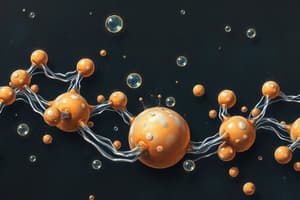Podcast
Questions and Answers
What are the building blocks of proteins?
What are the building blocks of proteins?
Amino acids
Which functional groups are present in amino acids?
Which functional groups are present in amino acids?
- Methyl group
- Hydroxyl group
- Amino group (correct)
- Carboxylic group (correct)
Zwitterion is a form of amino acid that has a net charge.
Zwitterion is a form of amino acid that has a net charge.
False (B)
What is a polypeptide?
What is a polypeptide?
Which amino acid is a complex amino acid often found at the catalytic site in proteins?
Which amino acid is a complex amino acid often found at the catalytic site in proteins?
What role does histidine play in the body?
What role does histidine play in the body?
Which amino acid is crucial for maintaining blood glucose levels?
Which amino acid is crucial for maintaining blood glucose levels?
What is the primary use of lysine?
What is the primary use of lysine?
Methionine is the last amino acid to be incorporated into proteins.
Methionine is the last amino acid to be incorporated into proteins.
Which amino acid is necessary for the optimal growth of infants?
Which amino acid is necessary for the optimal growth of infants?
Flashcards are hidden until you start studying
Study Notes
Introduction to Amino Acids
- Amino acids are the fundamental building blocks of proteins, influencing their biological functions.
- Crucial roles include growth, repair, and maintenance of all cells in the body.
Structure of Amino Acids
- Amino acids contain both amino (-NH2) and carboxylic (-COOH) functional groups.
- The N-terminal end has an amino group, while the C-terminal end has a carboxyl group, both bonding to the α-carbon.
- Peptide bonds form between the amino group of one amino acid and the carboxyl group of another.
- Amino acids exhibit amphoteric properties; they possess both basic and acidic characteristics.
- A zwitterion form exists where the amino acid carries both a positive and a negative charge but remains neutral overall.
- Polypeptides consist of chains of amino acids, averaging 100-150 in human serum.
- Variation among amino acids is determined by the unique chemical composition of their R-groups.
- Classification of amino acids includes:
- Structural classification
- Polarity classification
- Metabolic fate classification
- Nutritional classification
Essential Amino Acids
-
Arginine (Arg)
- Complex amino acid commonly found at enzyme catalytic sites due to its side chain.
- Functions include:
- Supporting cell division, wound healing, and protein synthesis.
- Enhancing immune function and hormone release.
- Stimulating thymus gland activity for T lymphocyte production.
- Assisting in urea generation for ammonia detoxification.
- Beneficial in liver disorders like cirrhosis and fatty liver.
- Crucial for creatine synthesis, which degrades to creatinine.
-
Histidine (His)
- Basic amino acid characterized by its imidazole side chain.
- Key roles include:
- Precursor for histamine synthesis.
- Source of carbon in purine synthesis.
- Supporting tissue growth, repair, and maintenance of myelin sheaths.
- Red and white blood cell production.
- Providing protection against heavy metal toxicity.
- Increased levels may correlate with stress and mental health disorders.
- Decreased levels linked to rheumatoid arthritis and potential nerve deafness.
-
Isoleucine (Ile)
- Classified as a branched-chain amino acid.
- Supports:
- Healing and repair of tissues, skin, and bones.
- Regulation of blood glucose levels and energy maintenance.
-
Leucine (Leu)
- Also a branched-chain amino acid.
- Promotes:
- Muscle, skin, and bone healing when combined with isoleucine and valine.
- Lower blood glucose levels and stimulate growth hormone production.
- Optimal growth in infants and nitrogen balance in adults.
-
Lysine (Lys)
- Carries a net positive charge, identifying it as one of the basic amino acids.
- Functions include:
- Supporting proper growth and bone development in children.
- Maintaining nitrogen balance in adults.
- Contributing to antibody production and lipid regulation (lowering triglycerides).
- Facilitating calcium absorption and collagen formation.
-
Methionine (Met)
- Vital for initiating mRNA translation, being the first incorporated amino acid in proteins.
- Functions encompass:
- Intermediate for cysteine, lecithin, and taurine biosynthesis.
- Source of sulfur essential for metabolism and growth.
- Aiding fat breakdown and reducing muscle weakness.
- Detoxifying lead and heavy metals.
- Reacting with ATP to assist in synthesizing epinephrine and choline.
Studying That Suits You
Use AI to generate personalized quizzes and flashcards to suit your learning preferences.




